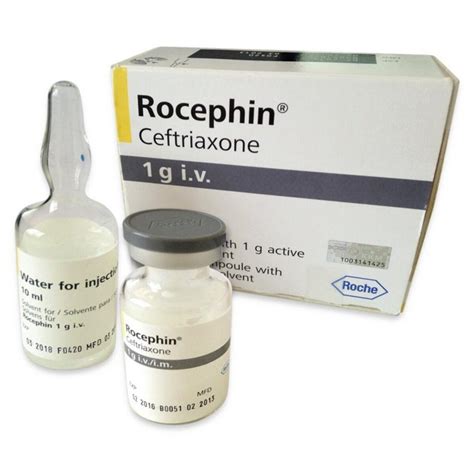Intro
Discover Rocephin shot information, including its antibiotic uses, dosage, and side effects. Learn about Ceftriaxone injections for bacterial infections, administration, and precautions.
The importance of understanding medication and its applications cannot be overstated, especially when it comes to antibiotics like Rocephin. Rocephin, also known by its generic name ceftriaxone, is a cephalosporin antibiotic used to treat various bacterial infections. Its effectiveness and the convenience of administration, such as through a shot, make it a commonly prescribed medication for a range of conditions. However, like all medications, it's crucial to understand its uses, side effects, and how it works to ensure safe and effective treatment.
Rocephin is administered via injection, either into a muscle (intramuscularly) or into a vein (intravenously), and is used to treat infections caused by bacteria, such as strep throat, pneumonia, and skin and soft tissue infections. The medication works by stopping the growth of bacteria, allowing the body's natural defenses to fight off the infection. Given its broad spectrum of activity, Rocephin can be used in both adults and children, though the dosage and method of administration may vary based on the patient's age, weight, and the type of infection being treated.
Understanding the specifics of Rocephin, including its benefits, potential side effects, and the conditions it treats, is essential for patients and healthcare providers alike. This knowledge helps in making informed decisions about treatment options and ensures that patients receive the most appropriate care for their specific condition. Moreover, with the rise of antibiotic resistance, the responsible use of antibiotics like Rocephin is more critical than ever, highlighting the need for education and awareness about these medications.
Introduction to Rocephin

Rocephin, or ceftriaxone, is a third-generation cephalosporin antibiotic. It is distinguished by its broad spectrum of activity against both Gram-positive and Gram-negative bacteria, including many strains that are resistant to other antibiotics. This makes Rocephin a valuable option for treating a variety of infections, from mild to severe. The drug is particularly noted for its long half-life, which allows for once-daily dosing in many cases, enhancing patient compliance and reducing the burden on healthcare systems.
How Rocephin Works
The mechanism of action of Rocephin involves inhibiting the synthesis of the bacterial cell wall, leading to cell lysis and death. This action is specific to bacteria, making Rocephin effective against bacterial infections while sparing human cells. The drug's ability to penetrate into most tissues and body fluids ensures that it can reach the site of infection effectively, providing therapeutic concentrations where they are needed most.Benefits of Rocephin

The benefits of Rocephin are numerous, including its broad spectrum of activity, once-daily dosing convenience, and effectiveness against a wide range of bacterial infections. This makes it a preferred choice for many healthcare providers when treating infections that require parenteral therapy. Additionally, its long half-life allows for less frequent administration, which can reduce the risk of adverse effects associated with more frequent dosing and improve patient compliance.
Common Uses of Rocephin
Rocephin is used to treat various bacterial infections, including: - Lower respiratory tract infections - Skin and skin structure infections - Urinary tract infections - Gonococcal infections - Pelvic inflammatory disease - Bacterial septicemia - Bone and joint infections Its use in these conditions is based on its proven efficacy and the susceptibility of the causative pathogens to ceftriaxone.Administration and Dosage

The administration of Rocephin can be either intramuscular (IM) or intravenous (IV), with the choice depending on the severity of the infection and patient-specific factors. The dosage varies based on the type of infection, patient age, weight, and renal function. For adults, typical doses range from 1 to 2 grams given once daily, though in certain cases, such as in the treatment of gonorrhea, a single dose of 250 mg IM may be used.
Dosage Considerations
- **Adults:** The usual dose is 1-2 grams every 24 hours. - **Pediatric Patients:** For children over 3 months of age, the dosage is generally 50-75 mg/kg/day given in a single dose or divided into two doses, not exceeding 2 grams daily. - **Neonates (0-3 months):** The dosage should not exceed 50 mg/kg/day.Side Effects and Precautions

Like all medications, Rocephin can cause side effects, though they are generally mild and temporary. Common side effects include:
- Pain, swelling, or redness at the injection site
- Diarrhea
- Vaginal itching or discharge
- Headache
- Dizziness
- Nausea or vomiting
- Rash
It's essential for patients to report any side effects to their healthcare provider, especially if they are severe or persistent.
Contraindications and Warnings
Rocephin is contraindicated in patients with known hypersensitivity to ceftriaxone or other cephalosporins. It should be used with caution in patients with a history of penicillin allergy, as cross-reactivity can occur. Additionally, in patients with renal or hepatic impairment, dose adjustments may be necessary.Interactions with Other Medications

Rocephin can interact with other medications, altering their efficacy or increasing the risk of side effects. Notable interactions include:
- Calcium-containing products: Should not be administered simultaneously with ceftriaxone in the same IV line due to the risk of precipitation.
- Aminoglycosides: Concurrent use may increase the risk of nephrotoxicity.
It's crucial for patients to inform their healthcare provider about all medications they are currently taking.
Storage and Disposal
Rocephin solutions should be stored in the refrigerator at 2-8°C (36-46°F) and used within the recommended timeframe. Any unused portion should be disposed of according to local regulations and guidelines for the disposal of hazardous waste.Conclusion and Future Directions

In conclusion, Rocephin is a versatile and effective antibiotic used in the treatment of a wide range of bacterial infections. Its broad spectrum of activity, convenience of administration, and safety profile make it a valuable option in clinical practice. However, the responsible use of antibiotics, including Rocephin, is critical to mitigate the development of antibiotic resistance. As research continues to evolve, understanding the benefits, risks, and optimal use of Rocephin will remain essential for healthcare providers and patients alike.
Final Thoughts
The future of antibiotic therapy, including the use of Rocephin, will depend on our ability to balance the need for effective treatments with the imperative to preserve the efficacy of these lifesaving medications. By promoting awareness, adherence to treatment guidelines, and the development of new antibiotics, we can work towards a future where bacterial infections remain manageable and curable.What is Rocephin used for?
+Rocephin is used to treat various bacterial infections, including lower respiratory tract infections, skin and skin structure infections, urinary tract infections, and others.
How is Rocephin administered?
+Rocephin can be administered either intramuscularly (IM) or intravenously (IV), depending on the type of infection and patient-specific factors.
What are the common side effects of Rocephin?
+Common side effects include pain, swelling, or redness at the injection site, diarrhea, vaginal itching or discharge, headache, dizziness, nausea, or vomiting, and rash.
We invite you to share your thoughts and experiences with Rocephin in the comments below. If you found this article informative, please consider sharing it with others who might benefit from this information. Your engagement is crucial in helping us provide the most relevant and useful content for our readers.
